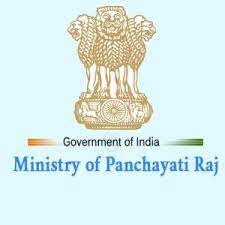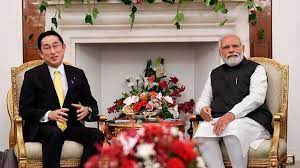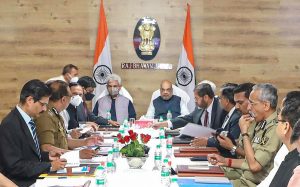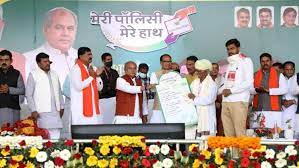Today Current Affairs: 21st March 2022 for UPSC IAS exams, State PSC exams, SSC CGL, State SSC, RRB, Railways, Banking Exam & IBPS, etc
Table of Contents
Man Booker International Prize 2022:

Delhi-based writer Geetanjali Shree’s 2019 novel Ret Samadhi became the first Hindi work of fiction, among 13 books, to be longlisted for the Man Booker International Prize.
- The novel has been translated into English by painter, writer and translator, Daisy Rockwell under the title Tomb of Sand.
- Man Booker International Prize is an international literary award hosted in the United Kingdom.
- The introduction of the International Prize to complement the Man Booker Prize was announced in June 2004.
- Sponsored by the Man Group, from 2005 until 2015 the award was given every two years to a living author of any nationality for a body of work published in English or generally available in English translation.]
- Since 2016, the award has been given annually to a single book translated into English and published in the United Kingdom or Ireland, with a £50,000 prize for the winning title, shared equally between author and translator.
DMP-MoPR: Important Points:

The Union Minister of Rural Development & Panchayati Raj released the Disaster Management Plan of the Ministry of Panchayati Raj (DMP-MoPR).
- DMP-MoPR has been prepared with a larger perspective of community-based planning starting from Village to District Panchayat level.
- Under the Plan, every Indian village would have a “Village Disaster Management Plan” and every Panchayat would have their Disaster Management Plan.
- The aim is to build disaster resilience at the grassroots level among the Panchayats and establish a framework to align the disaster management measures in rural areas to that of the National Disaster Management Authority.
- It incorporates many innovations in addition to being in compliance with Disaster Management Act 2005, National Disaster Management Policy 2009, and guidelines issued by National Disaster Management Authority.
- It comprehensively covers areas such as:
- Institutional arrangement for Disaster Management.
- Hazard Risk, Vulnerability and Capacity Analysis.
- Coherence of Disaster Risk Management across Resilient Development and Climate Change Action.
- Disaster Specific Preventive and Mitigation Measures-Responsibility Framework.
- Mainstreaming of Community Based Disaster Management Plan of Villages and Panchayats and so on.
World Happiness Report 2022:

The World Happiness Report 2022 was published by the United Nations Sustainable Development Solutions Network.
- This year marks the 10th anniversary of the World Happiness Report.
- World Happiness Report Published since 2012, the World Happiness Report is based on two key ideas:
- Happiness or life evaluation measured through opinion surveys and
- Identifying key elements that determine well-being and life evaluation across countries.
- The report usually ranks 150 countries based on several factors such as real GDP per capita, social support, healthy life expectancy, freedom to make life choices, generosity and perceptions of corruption.
- This year, the report ranked 146 countries.
- Every year, each variable measures a populated-weighted average score on a scale of 0-10 that is tracked over a period of time and further compared with other countries.
- This year, countries which ranked in the top 10 last year, moved upwards and downwards.
Performance of the Countries:
- Finland has been named the world’s happiest country for the fifth year running followed by Denmark.
- The biggest gains in happiness have taken place in Serbia, Bulgaria and Romania.
- Afghanistan was ranked as the unhappiest nation, followed by Lebanon, Zimbabwe, Rwanda and Botswana, respectively.
- India’s Performance: India saw a marginal improvement in its ranking, jumping three spots to 136, from 139 a year ago.
What Are Kamikaze Drones?

The US announced USD 800 million in new military aid for Ukraine, including 800 additional Stinger anti-aircraft missiles, 9,000 antitank weapons, 100 tactical drones including Kamikaze or suicide drones.
- Kamikaze are unmanned aircraft that are part of the tranche of weapons that are being sent by the US to Ukraine to assist their fight against Russia.
- Kamikaze drones also called Switchblade drones, these are small unmanned aircraft that are packed with explosives that can be flown directly at a tank or a group of troops that are destroyed when it hits the target and explodes.
- They are called Switchblade because their bladelike wings spring out on launch.
- The drones have the capability of going past traditional defences to strike its targets and also cost a fraction of what the larger counterparts do.
- These small lethal drones are difficult to detect on radar, and they can even be programmed to hit targets without human intervention, based on facial recognition.
- Although the Kamikaze might be the most advanced form of this genre of drones, Russia, China, Israel, Iran and Turkey all have some version of it
India Japan Summit:

Japanese Prime Minister Fumio Kishida arrived in India for his first visit to the country as the head of government. He met PM Narendra Modi for bilateral talks.
- India and Japan set an investment target of “five trillion yen” ($42 billion) in the next five years, the leaders announced after a meeting in New Delhi for the 14th annual summit, where several agreements were signed.
- The two sides also exchanged six agreements on cybersecurity, economic partnerships, waste-water management, urban development, a clean energy partnership and an agreement on promoting bamboo-based products from the northeast region.
- The “2+2” meeting of Foreign and Defence Ministers in the next few months is due to take forward agreements on the strategic partnership and PM Modi is expected to visit Tokyo in May or June, where he will also attend the Quad summit with the U.S. President and Australian Prime Minister.
Review Of The Progress Of Rehabilitation Of Kashmiri Migrants:

Union Home Minister Amit Shah reviewed the progress of rehabilitation of Kashmiri migrants, including Kashmiri Pandits, during a meeting with Jammu and Kashmir Lieutenant-Governor Manoj Sinha in Jammu.
- According to the Home Ministry, only 17% of the proposed accommodation for Kashmiri Pandits has been completed in the past seven years.
- The Union government, under the Prime Minister’s Development Package announced in 2015, had approved the creation of 3,000 government jobs for Kashmiri migrants in the erstwhile State of J&K. So far, 1,739 migrants have been appointed and 1,098 others selected for the jobs.
- A similar package for migrants was announced by the Manmohan Singh government in 2008 under which 2,905 jobs had been filled out of the 3,000 jobs approved.
- In 2015, as many as 6,000 transit accommodation units were announced for the members who were to be provided jobs by the J&K administration at a cost of ₹920 crore.
- According to the Ministry data, till February 2022, construction of only 1,025 units had been partially or fully completed while work at more than 50% units was yet to start.
- A large number of Pandits were forced to leave the Kashmir Valley from 1990 onwards due to rising terrorist attacks and calls for violence against the community.
- According to the Home Ministry, several Kashmiri migrants reside at existing transit accommodation at Vessu (Kulgam), Mattan (Anantnag), Hawl (Pulwama), Natnusa (Kupwara), Sheikhpora(Budgam) and Veerwan (Baramulla) in the Kashmir Valley other than the camps in Jammu.
- According to a 2020 parliamentary panel report, there are 64,827 registered migrant families in J&K — 60,489 Hindu families, 2,609 Muslim families and 1,729 Sikh families.
- Of the 64,827 families, 43,494 are registered in Jammu, 19,338 in Delhi and 1,995 families are settled in other States and Union Territories. Of the 43,494 migrant families, 5,248 are living in migrant camps.
Film Industry To Constitute Joint Committee On POSH Act: Kerala Govt

Kerala High Court has asked organisations associated with the film industry to take steps to constitute a joint committee to deal with cases of sexual harassment of women, in line with the Sexual Harassment of Women at Workplace (Prevention, Prohibition and Redressal) Act of 2013.
- The law against sexual harassment is commonly known as the prevention of sexual harassment or POSH Act, passed by Parliament in 2013.
- Sexual Harassment of Women at Workplace (Prevention, Prohibition And Redressal) Act, 2013 defines sexual harassment:
- It includes “any one or more” of the following “unwelcome acts or behaviour”committed directly or by implication: Physical contact and advances, Sexually coloured remarks, Showing pornography, A demand or request for sexual favours, Any other unwelcome physical, verbal or non-verbal conduct of sexual nature.
Key provisions of the act:
- This Act lays down the procedures for a complaint and inquiry and the action to be taken.
- It mandates that every employer constitute an Internal Complaints Committee (ICC) at each office or branch with 10 or more employees.
- It lays down the procedures and defines various aspects of sexual harassment.
- A woman can be of any age, whether employed or not, who “alleges to have been subjected to any act of sexual harassment”, that means the rights of all the women working or visiting any workplace, in any capacity, are protected under the Act.
Draft National Policy For The Medical Devices, 2022:

The Department of Pharmaceuticals (DoP), Ministry of Chemicals and Fertilizers released an Approach Paper for the Draft National Policy for the Medical Devices, 2022.
- Nearly 80% of the medical devices currently sold in the country are imported, particularly high-end devices.
- This new policy aims to reduce India’s import dependence to nearly 30% in the next 10 years.
- The policy aims to increase India’s per capita spending on medical devices.
- India has one of the lowest per capita spend on medical devices at $3 compared to the global average of per capita consumption $47.
Highlights of the Draft:
- Building Competitiveness through fiscal and financial support for stimulating the development of the local manufacturing ecosystem with private sector investments.
- Incentivise core technology projects and exports through tax refunds and rebates.
- Adopt Public-private partnerships to reduce the cost of healthcare and drive efficiency.
- Create a single-window clearance system for licensing medical devices.
- Identify critical suppliers and promote local sourcing.
- Encourage cross-industry collaboration.
- Increase the share of medical technology companies in research and development to around 50%.
- A dedicated fund for encouraging joint research involving existing industry players, reputed academic institutions and startups.
- Incorporate a framework for a coherent pricing regulation to make available quality and effective medical devices to all citizens at affordable prices.
Labour-Intensive Bharatiya Economic Model : RSS

The RSS has passed a resolution calling for a labour-intensive Bharatiya Economic Model in view of rising unemployment in the country.
- Society must come forward and participate in building an Atmanirbhar Bharat where the economic model is based on Indian values.
- The model should be human-centric, labour intensive, eco-friendly and lay stress on decentralisation and equitable distribution of benefits.
- It should augment village economy, microscale, small scale and agro-based industries.
- Thrust areas as rural employability, unorganised sector employment and employment of women as solutions to unemployment.
- It also urged the youth to come out of the mentality of seeking only jobs. An environment conducive to encouraging entrepreneurship should be created by educating and counselling people, especially youth.
- India’s unemployment rate has been rising, and when the effects of demonetisation and the pandemic have hit the economy and dried up opportunities.
- The unemployment rate went up to 7.91% in December 2021 from 6.3% in 2018-19 and 4.7% in 2017-18.
- The manufacturing sector is said to have lost 9.8 million jobs between 2019-20 and December 2021.
‘Meri Policy Mere Haath’ Campaign : By Karnataka

Meri Policy Mere Haath’ campaign was launched recently in Hassan, Karnataka.
- The campaign is part of the Pradhan Mantri Fasal Bima Yojana.
- It is aimed at motivating all farmers in the country to insure their crops.
- Under this program, every farmer who has taken insurance under the Pradhan Mantri Fasal Bima Yojana (PMFBY) will get the policy documents at their doorstep.
- The campaign empowers the farmers through crop insurance awareness and by bringing the insurance policy to their doorsteps.
- The campaign will also help in increasing the direct communication between the farmers and insurance companies.
- The Pradhan Mantri Fasal Bima Yojana (PMFBY) has successfully entered its seventh year of implementation with the upcoming Kharif 2022 season, completing six years of its implementation since its announcement on 18 February 2016.
- Till date, the scheme has insured over 30 crore farmer applications (5.5 crore farmer applications on year-on-year basis).
- Over the period of 5 years, more than 8.3 crore farmer applications have benefited from the scheme.
- Moreover, Rs.95,000 crores claims have been paid as against Rs. 20,000 crore farmers share.
What Is Extinction Rebellion?

World over activists of Extinction Rebellion are staging protests in various formats.
- Initially, launched in the United Kingdom on October 31, 2018, as a response to a report by the United Nations Intergovernmental Panel on Climate Change (IPCC).
- Now, it is a global movement which seeks to “rebel”, and asks groups to “self-organise”, without the need for anyone’s permission, to come up with collective action plans as long as they adhere to the group’s core principles and values.
- It is a decentralised, international and politically non-partisan movement using non-violent direct action and civil disobedience to persuade governments to act justly on the Climate and Ecological Emergency.
- The group has “three core demands” of governments around the world.
- It wants governments to “Tell the Truth”, to “Act Now”, and to “Go Beyond Politics” in order to confront the climate and ecological emergency that the world is faced with.
- The group had announced a “Declaration of Rebellion” at launch, involving a public act of civil disobedience in London, demanding that the government reduce carbon emission to zero by 2025.
- The eventual plan was to coordinate actions in other countries and to engage in an “International Rebellion” in March 2019.
- The XR global website, however, states that the movement is “strictly non-violent”, and that they are “reluctant law-breakers”.
- In April 2019, Greta Thunberg, the teenage Swedish climate activist, lent her support to the group by speaking to its members in London.




